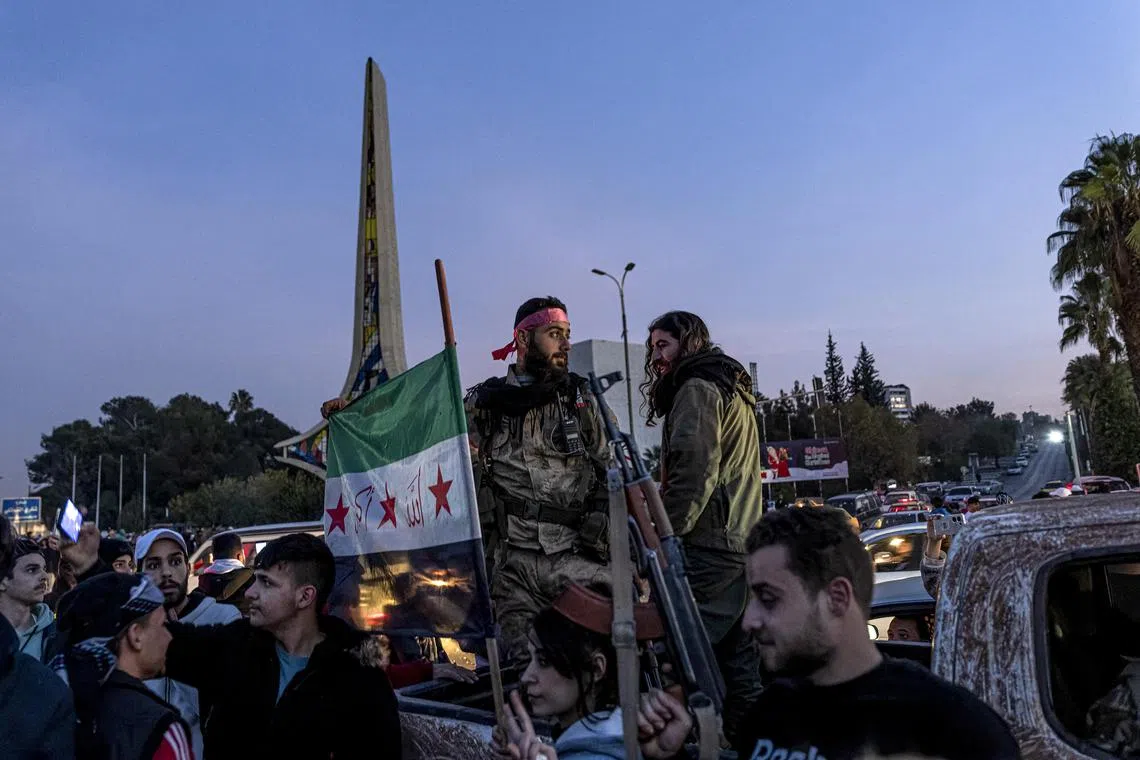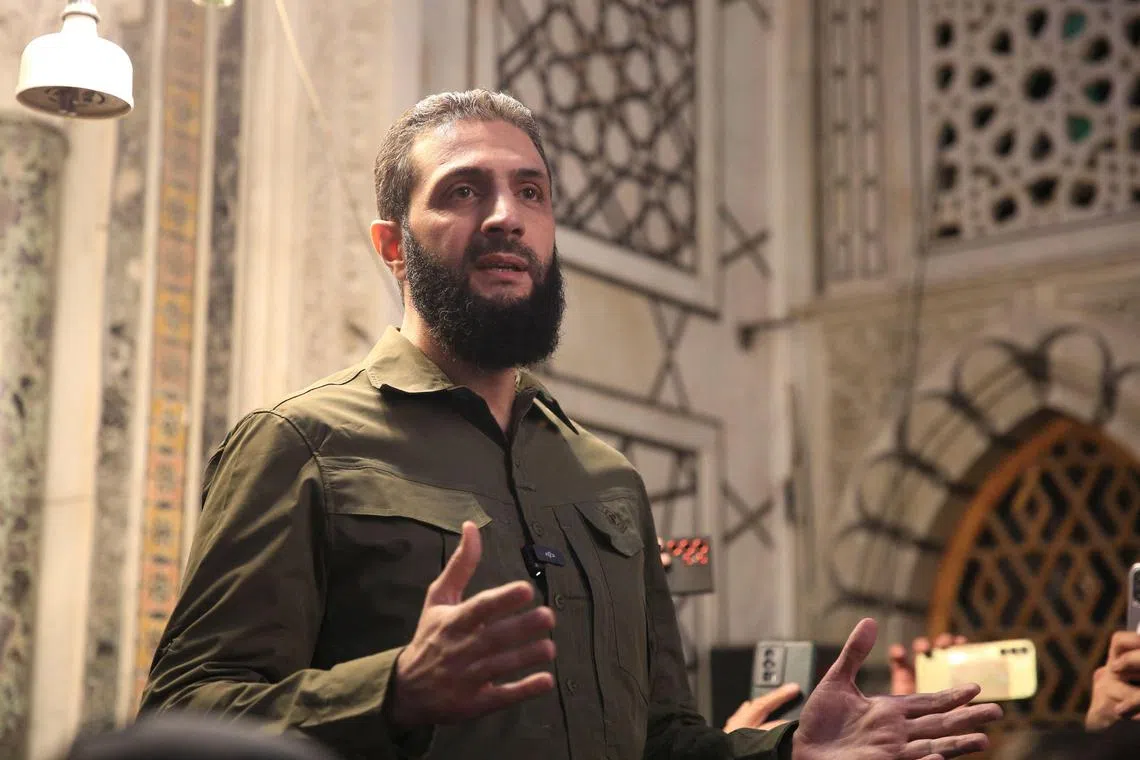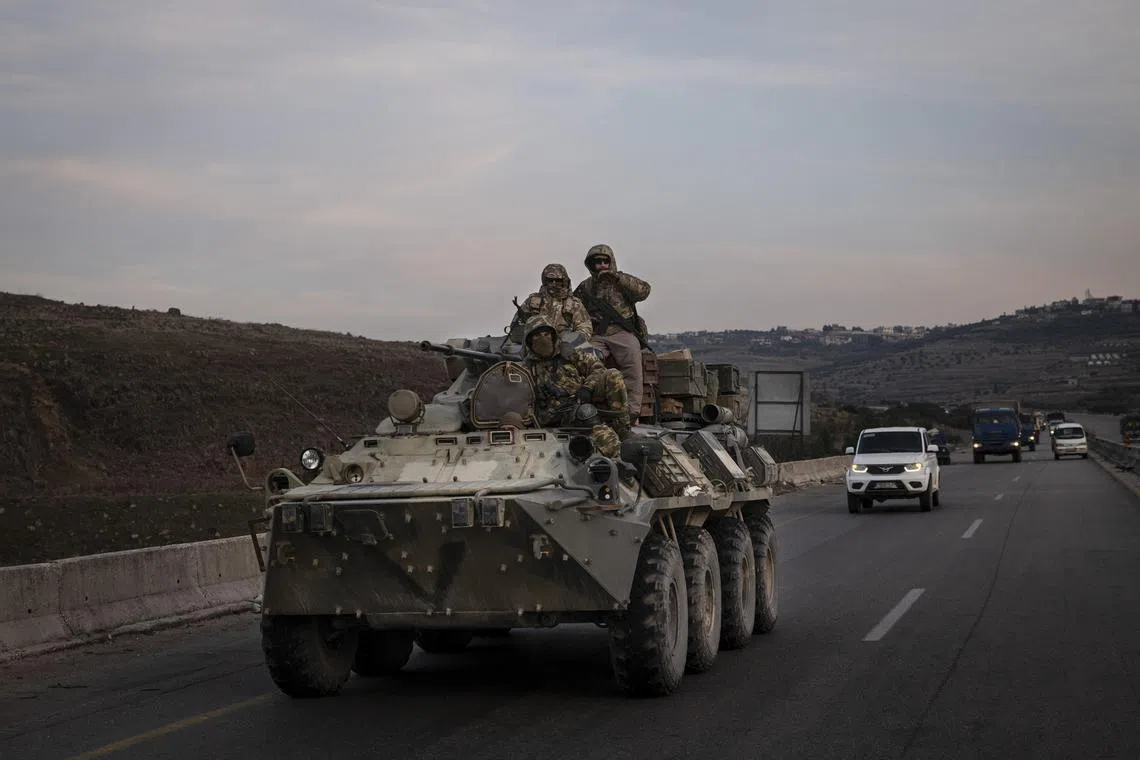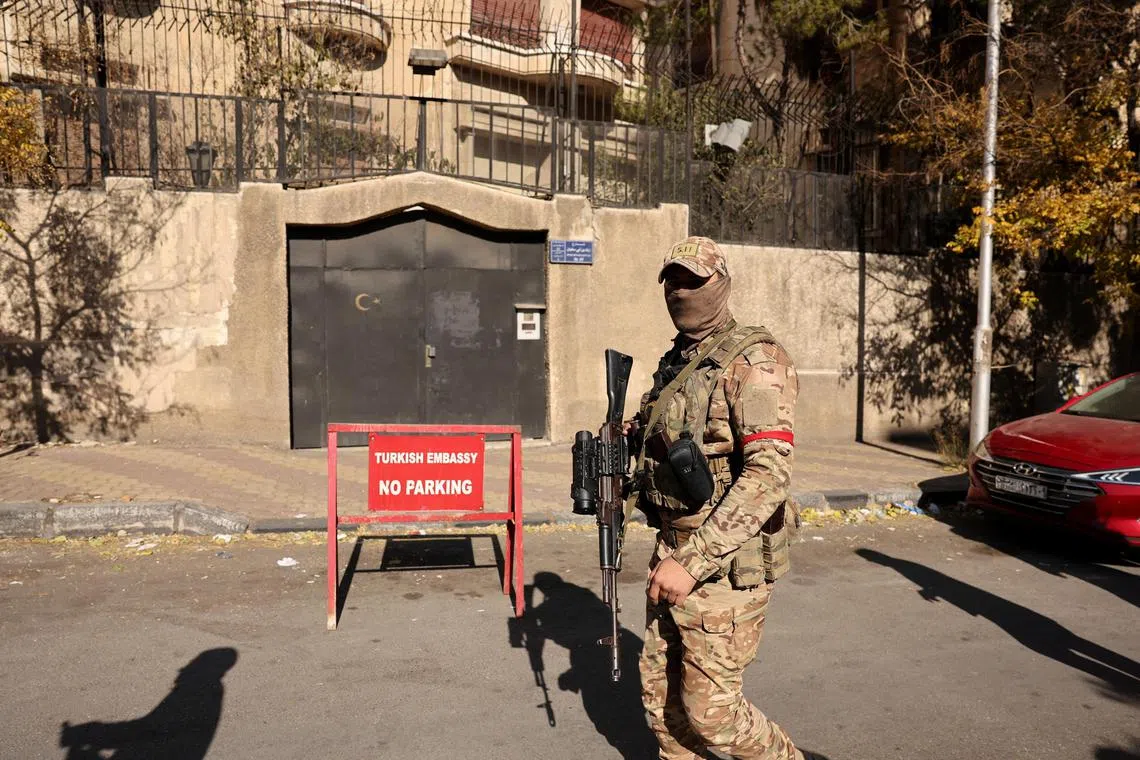Syria after Assad: How will the rebels govern?
Sign up now: Get ST's newsletters delivered to your inbox

The rapid rise of rebel group Hayat Tahrir al-Sham has left many questions unanswered, especially how it might govern the fractious country.
PHOTO: NYTIMES
Follow topic:
Mr Ahmad al-Sharaa, the leader of the rebel group that ousted the Assad regime in Syria, said this weekend that “Syria’s war-weary condition, after years of conflict and war, does not allow for new confrontations”.
But the rapid rise of Mr Sharaa’s group to power has left many questions unanswered, especially how it might govern the fractious country. And there are many confrontations already in motion, including a violent conflict between Turkey-backed militias and Kurdish-led forces, and Israel’s ongoing air strikes on Syrian military sites.
Here’s a guide to understanding where things stand in Syria, and what may come next.
How will the rebels govern Syria?
Hayat Tahrir al-Sham (HTS) was the main rebel group leading the offensive that quickly led to the fall of President Bashar al-Assad
Mr Mohammad al-Bashir, a rebel leader affiliated with HTS, has been named as caretaker prime minister until March 1. Mr Bashir previously served as head of the administration in Idlib, a rebel-held territory in the north-west.
HTS’ track record there may offer some clues to how it will oversee a much larger territory. The group maintained a robust internal security force to confront other military factions and domestic critics, prompting regular protests against its authoritarian methods and harsh jail conditions.
It is an open question whether these rebels can scale up what they achieved in Idlib, a poor, agrarian region with a relatively small population, throughout most of Syria.
The alliance said it would grant an amnesty for lower-level government workers and soldiers, but vowed to hunt down and punish senior officials of the previous regime who were implicated in torture and other abuses.
“We will not relent in holding accountable the criminals, murderers, and security and military officers involved in torturing the Syrian people,” said Mr Sharaa, who was formerly known by the nom de guerre Abu Mohammad al-Jolani.
The group is a former affiliate of al-Qaeda that broke with the older group years ago and came to dominate Idlib, the last stronghold of Syria’s opposition during the 13-year civil war.
Mr Geir Pedersen, the United Nations’ special envoy for Syria, said on Dec 10 that HTS and other armed groups controlling the capital had issued “reassuring statements” about forming a government of “unity and inclusiveness”. He urged Syria’s armed groups to protect civilians and create a government that represented the country’s many ethnic and religious communities.
Who is Ahmad al-Sharaa?
Mr Sharaa of HTS recently gave up his nom de guerre after concluding the shocking military offensive that unseated the Assad regime.
He was born Ahmad Hussein al-Sharaa in Saudi Arabia, the child of Syrian exiles, according to Arab media reports. In the late 1980s, his family moved back to Syria, and in 2003, he went to neighboring Iraq to join al-Qaeda and fight the US occupation.

Mr Ahmad Hussein al-Sharaa, the leader of Syria’s Islamist Hayat Tahrir al-Sham group addresses a crowd at the capital’s landmark Umayyad Mosque on Dec 8.
PHOTO: AFP
He spent several years in a US prison in Iraq, according to the Arab media reports and US officials. He later emerged in Syria around the start of the civil war and formed the Nusra Front, which eventually evolved into HTS.
Since breaking ties with al-Qaeda, Mr Sharaa and his group have tried to gain international legitimacy by putting aside global jihadi ambitions and focusing on organised governance in Syria.
Questions have emerged about what kind of government Mr Sharaa would support and whether Syrians would accept it. In Idlib, HTS has espoused a government guided by a conservative and at times hard-line Sunni Islamist ideology.
Since the rebel offensive began, Mr Sharaa has sought to reassure minority communities from other sects and religions. Some analysts say he now faces the test of his life: whether he can unite Syrians.
What is Russia doing in Syria?
Russia was a key backer of the Assad regime, intervening in Syria’s civil war with brutal bombing campaigns that helped the government defeat rebel groups. It also maintained a military presence throughout the country, including the Tartus naval base and Hmeimim air base, enabling Russia to project military power throughout the Mediterranean and northern Africa.
Since the rebel alliance deposed Mr Assad, Russia has moved to scale down its presence. But one key question has yet to be resolved: whether Russia manages to strike an agreement with Syria’s new government to hold on to Hmeimim and Tartus.
A New York Times analysis of satellite imagery of Hmeimim on Dec 13 showed planes designed to transport heavy machinery prepared for loading
Two videos verified by the Times also showed at least one convoy of Russian military vehicles moving north, near Damascus and Homs, in the direction of the air base.
Russian naval and commercial activity in the key Syrian deepwater port of Tartus has also ceased since Assad’s government fell.

A convoy of Russian military vehicles and armoured personnel carriers on a road west of Homs, Syria, moving towards the Mediterranean Sea from their bases on Dec 15.
PHOTO: NYTIMES
What is Israel doing?
Israel is carrying out intensive air strikes on military targets that were controlled by the Assad government, despite warnings that its operations there could ignite new conflict and jeopardise the transition of power to an interim government.
Its ground forces have advanced beyond the demilitarised zone on the Israel-Syria border, their first overt entry into Syrian territory in more than 50 years, including on the Syrian side of the strategic Mount Hermon
On the night of Dec 14, Israel carried out 75 air strikes near the Syrian capital, Damascus, and the cities of Hama and Homs, according to the Syrian Observatory for Human Rights, an organisation based in Britain that has long tracked the conflict in Syria. There were no immediate reports of casualties.
Israel has struck Syria more than 450 times since the collapse of the Assad regime a week ago, according to the observatory.
Mr Sharaa said in an interview on Dec 14 with Syria TV, a pro-opposition channel, that Israel was using pretexts to justify its “unwarranted” territorial seizures in Syria. Still, he said, Syria could not afford any further conflict.
“Syria’s war-weary condition, after years of conflict and war, does not allow for new confrontations,” he said, adding that he was focused on diplomatic solutions. “The priority at this stage is reconstruction and stability, not being drawn into disputes that could lead to further destruction.”
What is Turkey doing?
Turkey has emerged as a winner of the Syrian civil war, with more influence than ever over the rebels who now control most of the country.
Its President Recep Tayyip Erdogan, had long worked with and supported the Syrian rebels who forced Mr Assad to flee.
He took in more than 3 million Syrian refugees and committed Turkish troops to secure a buffer zone inside Syria. He funded and trained a Turkish-backed rebel force, the Syrian National Army, which provided security for Turkish military bases in northern Syria and helped Turkey fight Kurdish forces that officials in Ankara, the Turkish capital, viewed as a threat.
Fierce fighting has already taken place between rebels supported by Turkey and US-backed, Kurdish-led forces. On Dec 10, Kurdish forces in Manbij announced a ceasefire brokered by the United States.
The US and an independent group monitoring the war have said that Turkish warplanes have assisted their allies on the ground with air strikes. Turkey and the US, allies in Nato, both welcomed the fall of the Assad government over the weekend. But one of Turkey’s central strategic goals in the region is to weaken Kurdish forces, putting it at odds with Washington.
HTS is designated a terrorist organisation by Turkey, the United States and other nations because of its history of Islamist extremism, but the Turks found a way to work with them and now have enormous leverage.

A fighter walks outside the Turkish Embassy, after fighters of the ruling Syrian body ousted Syria’s Bashar al-Assad, in Damascus, Syria, on Dec 14.
PHOTO: REUTERS
“Out of all the region’s major players, Ankara has the strongest channels of communication and history of working with the Islamist group now in charge in Damascus, positioning it to reap the benefits of the Assad regime’s demise,” Dr Gonul Tol, director of the Middle East Institute’s Turkish program, wrote in Foreign Affairs magazine on Dec 12.
Turkey has provided indirect assistance to the group, Dr Tol wrote, by shielding it from Syrian government attacks through the presence of Turkish troops in Idlib province. It also channeled humanitarian aid and trade into the region, which helped HTS gain legitimacy among the people of the region.
“All this has given Turkey influence over” HTS, she wrote.
What is the US doing?
The main US interest in Syria is the defeat of the Islamic State group, also known as Isis, which maintains a presence in the north-eastern and central parts of the country. About 1,000 US Special Operations troops are housed in bases in the east and north-east of the country, often working closely with Syrian Kurdish troops.
President Joe Biden authorised US air strikes last week against Islamic State group camps and operatives inside Syria. A swarm of B-52, F-15 and A-10 warplanes hit more than 75 targets in central Syria, according to US officials.
He said the United States would support the region “should any threat arrive from Syria during this period of transition”.
“We’re cleareyed about the fact that Isis will try to take advantage of any vacuum to reestablish its capability, to create a safe haven,” Mr Biden said. “We will not let that happen.”
What are the internal factions in Syria?
In addition to HTS, there are several major armed groups in Syria, and many smaller ones:
Syrian Democratic Forces
Forces from Syria’s Kurdish ethnic minority, which makes up about 10 per cent of the population, became the United States’ main local partner in the fight against the Islamic State group in Syria, under the banner of the Syrian Democratic Forces.
After the Islamic State group was largely defeated in 2019, the Kurdish-led forces consolidated control over towns in the north-east, expanding an autonomous region they had built there. But Kurdish fighters still had to contend with a longtime enemy, Turkey, which regards them as linked to Kurdish separatist insurgents in Turkey.
Syrian National Army
This umbrella group, which includes dozens of groups with different beliefs, receives funding and arms from Turkey, which has long been focused on expanding a buffer zone along its border with Syria to guard against the activities of Kurdish militants.
Turkey wants to create an area where it can resettle some of the 3 million refugees who have fled Syria and are living within its borders. But it has struggled to harmonise the ragtag groups that make up the Syrian National Army.
The group is largely composed of the dregs of the Syrian civil war, including many fighters whom the United States had rejected as criminals and thugs. Some received training from the United States early in the war, but most were dismissed as too extreme or too criminal. Most have no clear ideology and had turned to Turkey for a paycheck of about US$100 (S$135) a month when the group was formed.
The Druse militia
Syria’s Druse minority is concentrated in Sweida, an area in the south-west. Last week, Druse fighters joined the push to topple the Assad regime, launching an offensive in the south-west and clashing with government forces, according to media reports.
The Druse fighters are part of a newly formed group of Syrian rebels, which includes fighters from other backgrounds, working under the name the Southern Operations Room.
The Druse are a religious group practicing an offshoot of Islam, developed in the 11th century, that contains elements of Christianity, Hinduism, Gnosticism and other philosophies. There are more than 1 million Druse across the Middle East, mostly in Syria and Lebanon, with some also in Jordan and Israel.
Islamic State group
The Islamic State group in Iraq and Syria, also known as Isis, seized vast stretches of territory in Syria and Iraq in 2014, establishing a brutal caliphate before it was beaten back by a US-led coalition. Now its members are largely in hiding.
Lately, there have been signs of the group’s resurgence in Syria amid wider instability in the region. The Pentagon warned in July that Islamic State group attacks in Syria and Iraq were on track to double compared with 2023. The group has repeatedly tried to free its members from prisons and has maintained a shadow governance in parts of north-eastern Syria, the US said.
On Dec 10, Islamic State group forces killed 54 people in the Homs region in central Syria who had been part of the Syrian government’s military and fled during the collapse of the Assad regime, according to the Syrian Observatory for Human Rights. NYTIMES

